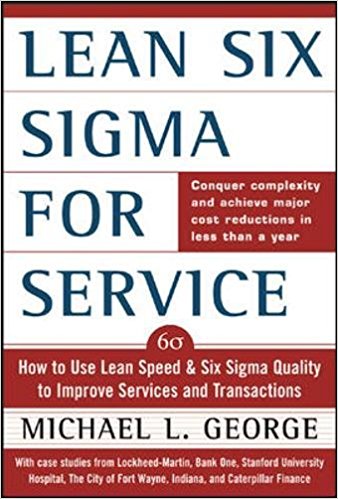Lean Six Sigma for Services Summary

5 min read ⌚
 How to Use Lean Speed and Six Sigma Quality to Improve Services and Transactions
How to Use Lean Speed and Six Sigma Quality to Improve Services and Transactions
Companies in the digital era despite their efforts to Improve the customer service, fail to reach the prosperity stage.
The quality of “Six Sigma” surely is the highlight of the show.
Who Should Read “Lean Six Sigma for Services”? And Why?
Nevertheless, companies should try to minimize variability under any circumstances. Apparently, this is not a straightforward activity, that can be done instantly. A lot of preparation and a set of quality management methods are needed.
These Sigma experts understand the value of a well-organized firm. Each Six Sigma project or activity conducted at any stage follows a defined sequence of steps that target a specific benefit like: improve customer service, reduce cycle time or increase profits.
This book is perfect for newcomers to the world of business, and for other people already familiar with the difficulty of managing a company.
About Michael L. George
 Michael L. George operates in a major Six Sigma consulting company as a CEO – George Group. His knowledge helped many enterprises placed in the Fortune 500 companies.
Michael L. George operates in a major Six Sigma consulting company as a CEO – George Group. His knowledge helped many enterprises placed in the Fortune 500 companies.
Only by using Lean Six Sigma, Lean methodology and Manufacturing, these brands reached long-term growth. As an author, he also wrote – What Is Lean Six Sigma?
“Lean Six Sigma for Services Summary”
Not many leaders are able to spot the difficulties related to the service sector. Few business leaders are aware of the power emerging from this industry. According to numerous statistics, it reaches up to 80% of U.S. GDP and continues to grow without stopping.
You mustn’t disregard the economic significance because it influences every other organizational aspect. Another key point of this massive phenomenon is that services are gaining momentum. In fact, this concept is snowballing. Given these points, the economic significance is immense.
Many statistics have shown that in almost any manufacturing organization, nearly 80% of the operational cost can be traced back to service activities and functions. That is a clear indicator of the limited – only a fifth of the cost derives from direct manufacturing and other tangible materials.
Nevertheless, providing services takes much practice and effort. This book has a task to help you on that journey by presenting a series of methods for that purpose. Generally speaking, customers find that approximately 50% of most service produce a little value. The same thing goes for the support costs which according to many are a waste of time, energy, and money.
The corporate life brings a lot of challenges, without warning, Businessmen and other key decision-makers must be prepared for streamlining those fundamental processes and make the organization function flawlessly.
This is easier said than done, but it’s not something that’s too difficult to attain. The question is – How to speed-up the service delivery process without compromising the quality of execution?
For instance, if you are running a newly established start-up company, you are aware of what’s is your current status on the market. Unrealistic expectations can cause massive troubles, which would sooner or later destroy your company.
In either case, every firm strives to work faster, and increase the quality of its products or services. That doesn’t come as a surprise to anyone. However, something worthy of your attention is – how to do that?
Preparation and a flexible attitude are the essential elements to succeed on this dusty and enigmatic path. This book comes as a blessing to those familiar with Six Sigma effects and to those eager to understand them in details. The author – Lean Six Sigma expert, encountered hundreds of similar service setbacks.
The tactics he used for solving them are present in this one of a kind-service-book.
Before you learn about the values of service, a person must always strive and seek to find a way to improve the quality of the output of any commodity. This process is carried out by a team of professionals who should identify and eliminate all the activities which cause defects or any other issues.
This procedure covers all industries related to manufacturing or service providing. The market fluctuations are also a factor that mustn’t be neglected.
The case used is only a reflection of the everyday real-world issues present in almost every company. The voice of the customer counts them most because that is the voice of reason, to which you must pay extra attention.
Address their perspective about the service you’re providing. GetNugget believes in this magnificent book which is best suited for managers, owners, entrepreneurs, and businessmen.
Global brands know that the secret to success lies in becoming a friendly-oriented organization whose interests are manifested in the eyes of its customers.
Key Lessons from “Lean Six Sigma for Services”
1. Corporate operations emerged from an idea
2. Six Sigma targets only the big players
3. Complexity is a hidden expense
Corporate operations emerged from an idea
Quite often, the people who are in one way or another linked to these so-called corporate services are forced to adopt a more open, broad, and unbiased perspective.
Profits come from a vision, put into execution.
Six Sigma targets only the big players
Reducing costs is not always such a great idea. Six Sigma differs from other approaches due to its ability to achieve profound improvements in various aspects related to daily operations.
Accelerate processes and eliminate those bottlenecks, once and for all.
Complexity is a hidden expense
How a manager handles the internal processes speaks a lot about that company. Complexity is always an obstacle that a good leader must overcome. If you cannot reduce the life-cycle of certain activities, prepare yourself for a bumpy ride. The costs will just keep growing!! You better do something and normalize these functions.
Like this summary? We’d Like to invite you to download our free 12 min app, for more amazing summaries and audiobooks.
“Lean Six Sigma for Services” Quotes
We can only speed up process time by controlling (and usually slowing) release of work into the process. Share on X It is vital to have a deployment team and plans for internal and external communication. Share on X Every successful deployment is based on a ’burning platform,’ some major challenge or risk which, if overcome, will push the organization towards greatness. Share on X Think of complexity reduction as a new competitive weapon and a potent tool to increase shareholder value. Share on X The first step in capturing the Voice of the Customer is determining the appropriate customer segment...Once the customer segments are known, they need to be prioritized. Share on XOur Critical Review
Michael L. George, shares tips on how to best apply both Lean and Six Sigma into your service operation. His methods are straightforward and transparent because they create a road for accomplishing long-term goals.








